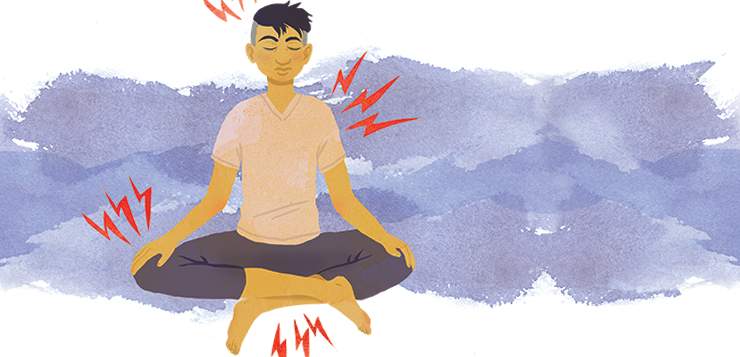Pain. Even hearing (or reading) the word can elicit a wince from just about anyone who has ever experienced it—and that would be everyone.
Pain presents itself in myriad forms and textures—acute and chronic, intense and mild. It affects us physically and emotionally—sometimes both at once. Experiencing it is an unavoidable reality of being human. And yet we spend a significant portion of our lives trying to avoid it.
What might happen, then, if we were to stop trying to resist pain? Consider these tips for managing whatever pains you, now or in the future.
1. Trust your body
Feeling pain doesn’t mean your body has failed. In fact, it signals a body doing its job by letting you know something’s up. By heeding its wise (if blunt) counsel, you can effectively identify and deal with the cause.
2. Resist resistance
For most of us, the natural response to pain signals is resistance—to push them away or deny that they even exist. Yet ignoring pain only serves to add an extra layer of angst to an already unpleasant situation. Not only do you still have the pain to deal with, but now you have to keep up the ruse that the pain isn’t really there. Inviting pain in is the first step to understanding how to come to terms with it.
3. Put it under the microscope
When you acknowledge pain you have the opportunity to study it, to bring the quality of calm investigation to an experience that may have at first seemed like a scary jumble of sensations. Where does it originate? How does it travel through your body? Where is it most strongly felt, and where does it taper? Take note of precise characteristics: heat, coolness, tingling, tightness, vibration, pressure. By learning the patterns, the fine points, and even the temperament of your pain, you can start to peel away its intimidating mask.
4. Dig in, and dig deep
Pain has a more complicated personality than you think—so don’t quit the conversation at the “small talk” phase. Bring an attitude of interest, receptivity, and curiosity, which will prepare you to stick around for long enough to get comfortable with the idea of discomfort. Like all conversations, your investigation of pain is likely to contain pauses, even long moments of rest, and will have various components, all in flux. The more you notice this, the more likely you are to understand pain’s changeable nature.
5. Let it flow
Let go of the expectation that pain will pass the way you want it to, and on your timeline. Pain keeps its own counsel; luckily, you are free to do the same. Understanding its subtleties, all its fluctuating facets, will help you to experience pain less like two rocks smashing against each other, to a rock around which a river easily bends, and finally, to two streams crossing paths and continuing on their way.

6. Sweat the small stuff
Pain is not only present in big events, like post-knee surgery or at the loss of a loved one. Pain is a real and legitimate presence even in events as small as stubbing your toe or feeling the humiliation of being cut off in traffic. Let these minor pains go unnoticed at your peril, as other pains may stick to them, causing an unsavory accumulation. Take time to examine and come to terms with even the tiniest pains you encounter.
7. Give joy its due
Bravely facing pain—be it in small or large slices—need never be an all-consuming activity. Leading a life grounded in mindfulness involves examining pain when present, as well as making plenty of room for all the things that bring us joy. Whatever they may be for you, you can and should engage them not only when pain is absent, but when it is present, too.
8. Get contemplative
Contemplative activities such as yoga, meditation, coloring, or walking in nature can activate joy by themselves, and will also support increased focus when examination of pain is required. Contemplative training also reminds you to ask yourself, “What do I need most in this moment?”
9. Treat yourself
The readiness to rise to the occasion of pain can be bolstered by an established routine of self-care. Self-nurturing habits like eating well and getting enough sleep can help sustain an attitude of calm, clear attention when the challenging circumstances related to pain set in. Enlisting the support of trusted friends and telling them what you need is another way to feel supported and protected. Make sure to continue these routines as best you can during periods in which pain is particularly troublesome.
10. Breath’s got your back
Simple breathing exercises can help curb the anxiety that often accompanies the onset of pain. Try this: Rest attention on the sensations present when you inhale, and when you exhale. Allow your exhalations to be slightly longer than your inhalations—this will engage the parasympathetic nervous system, provoking a calming response. From this vantage point, pain signals can be examined more effectively.
11. Keep it in perspective
Pain can seem like a kind of teacher—enabling us to bring an astute sense of knowing to a vital and unavoidable aspect of the human experience—but it should not be considered a greater teacher than pleasant or neutral feelings. It’s important to not seek pain out, or to idolize it. Pain is not the great teacher. Life is the great teacher, and pain is just one of its many lessons.





